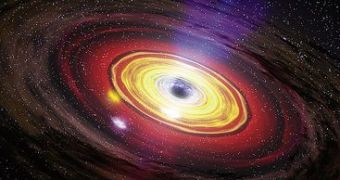A new stellar black hole has been discovered by two CNRS astronomers collaborating with a researcher from London. It is a miniature version of some supermassive black holes from the active nuclei of galaxies and it emits powerful jets of particles 1,000 light years in length. Situated at twelve million light years away from the Earth, its location is at the edge of galaxy NGC 7793.
Scientists thought until now, that the energy produced by matter falling into black holes was turned into radiation, and most of it was X-rays. This new discovery contradicts this theory and shows that certain black holes can emit enormous amounts of energy as particles jet. The interesting thing is that these jets, once they get in contact with interstellar gas, start a huge Shockwave. This causes heating and it speeds up the expansion of the bubble.
Astronomers observed two jets of matter and noticed that they are the most powerful ever discovered for a black hole coming from the collapse of a star. These jets pushed back the interstellar medium (the material that fills the space between the stars) and created a large bubble of relativistic speed particles, along with extremely hit gases around the black hole. This bubble has been expanding for 200,000 years now, and it measures 1,000 light years in diameter. It does not only radiate in X-ray wavelengths, but also in optical and radio wavelengths, growing in diameter at almost one million kilometers per hour.
Jets of particles have been reported flowing in the intergalactic medium, when it comes to active nuclei gases containing supermassive black holes. Scientists now hope to find out how these powerful jets are created and what impact do they have on the immediate and more distant environment of a black hole.
The two CNRS astronomers from the Observatoire Astronomique de Strasbourg (CNRS/Université de Strasbourg, Observatoire des Sciences de l'Univers-INSU) and their peer from the University College London, made this discovery by using the Very Large Telescope (ESO, Mount Paranal, Chile) and the Chandra X-ray telescope (NASA), which orbits the Earth.
This extraordinary discovery is mentioned in the journal Nature of 8 July 2010.

 14 DAY TRIAL //
14 DAY TRIAL //